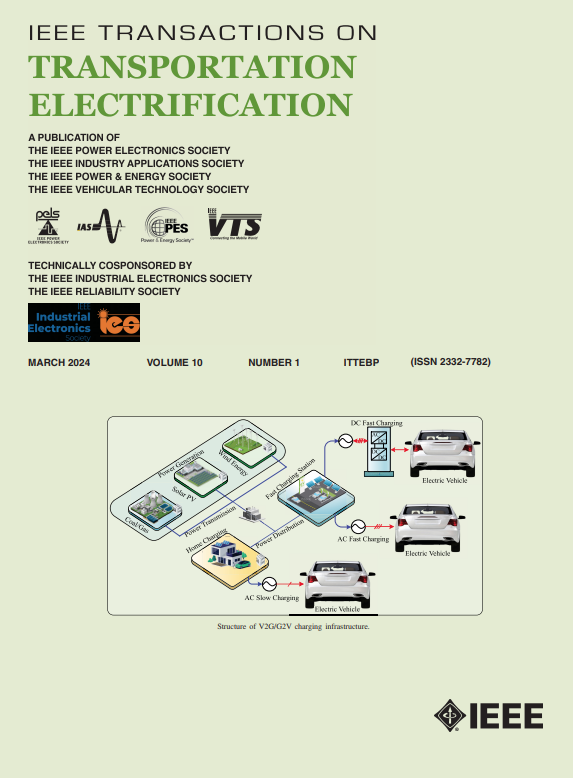基于动态电压边界调节的无电解电容永磁同步电机过调制策略
IF 8.3
1区 工程技术
Q1 ENGINEERING, ELECTRICAL & ELECTRONIC
IEEE Transactions on Transportation Electrification
Pub Date : 2025-03-11
DOI:10.1109/TTE.2025.3549980
引用次数: 0
摘要
由于直流电压的周期性和参考电压矢量的波动,导致无电解电容永磁同步电动机(PMSM)驱动器在过调制(OVM)区存在明显的谐波。为了解决这一问题,提出了一种基于动态电压边界(DVB)调节的OVM策略。通过分析考虑周期波动的输出电压矢量轨迹,揭示了开关混叠引起的定子电压谐波。OVM区域由包含参考电压矢量特征的动态电压划分。然后利用直流电压和动态电压得到基波矢量的作用时间。基于动态电压的波动信息,OVM区域可以与参考电压矢量幅值的直流分量平滑切换。该方法可以减小参考调制指数(RMI)的波动,从而降低定子电压和电流的总谐波失真(THD)。在2.2 kW无电解电容PMSM平台上的实验结果验证了该方法的有效性。本文章由计算机程序翻译,如有差异,请以英文原文为准。
Overmodulation Strategy Based on Dynamic Voltage Boundary Regulation for Electrolytic Capacitorless PMSM Drives
Due to the periodic dc-link voltage and the fluctuation of the reference voltage vector, which is caused by the incomplete voltage compensation, the electrolytic capacitorless permanent magnet synchronous motor (PMSM) drives have obvious harmonics in overmodulation (OVM) regions. To address this issue, a novel OVM strategy based on dynamic voltage boundary (DVB) regulation is proposed. By analyzing the trajectories of output voltage vectors with the consideration of periodic fluctuation, the harmonics of stator voltage caused by switching aliasing in OVM regions are revealed. The OVM regions are divided by a dynamic voltage which contains the characteristics of reference voltage vectors. Then the action time of fundamental vectors can be obtained by using the dc-link voltage and the dynamic voltage. Based on the fluctuating information of dynamic voltage, OVM regions can be smoothly switched with the dc component of the amplitude of reference voltage vectors. The proposed method can reduce the fluctuation of reference modulation index (RMI), thus decreasing the total harmonic distortion (THD) of stator voltage and current. Experimental results on a 2.2 kW electrolytic capacitorless PMSM platform validate the effectiveness of the proposed method.
求助全文
通过发布文献求助,成功后即可免费获取论文全文。
去求助
来源期刊

IEEE Transactions on Transportation Electrification
Engineering-Electrical and Electronic Engineering
CiteScore
12.20
自引率
15.70%
发文量
449
期刊介绍:
IEEE Transactions on Transportation Electrification is focused on components, sub-systems, systems, standards, and grid interface technologies related to power and energy conversion, propulsion, and actuation for all types of electrified vehicles including on-road, off-road, off-highway, and rail vehicles, airplanes, and ships.
 求助内容:
求助内容: 应助结果提醒方式:
应助结果提醒方式:


